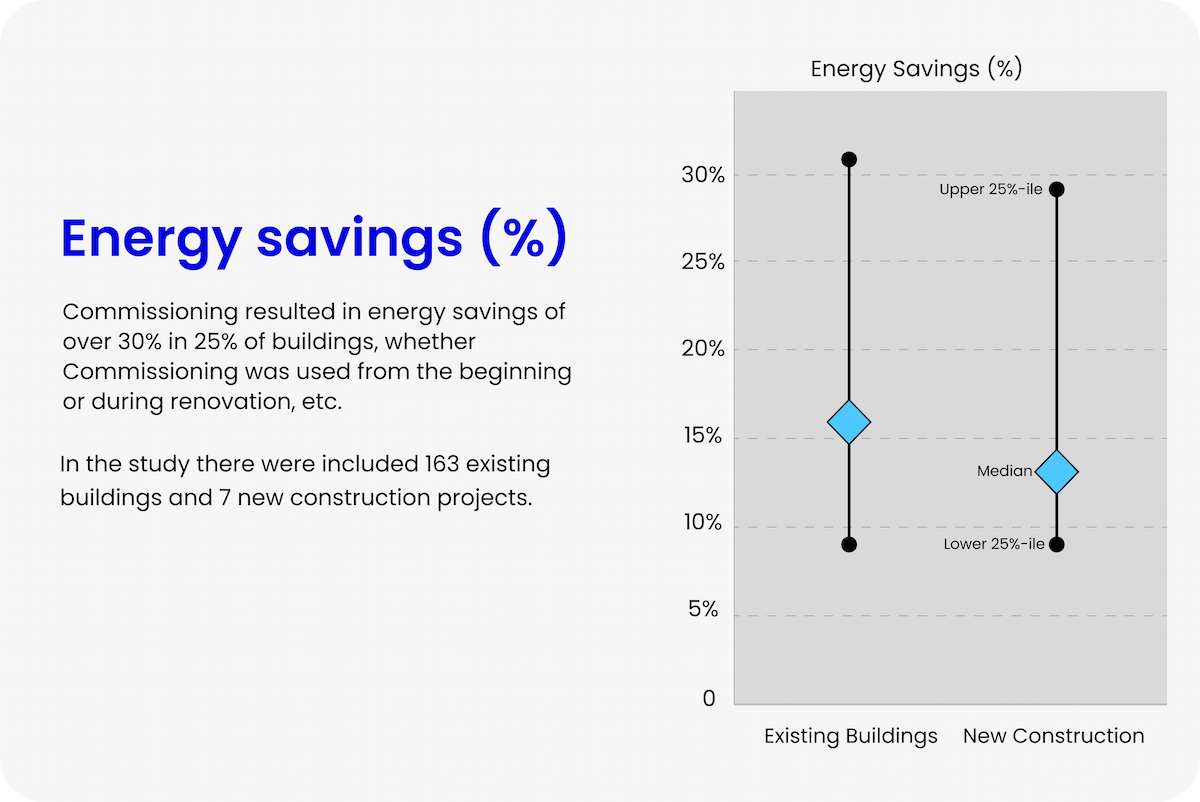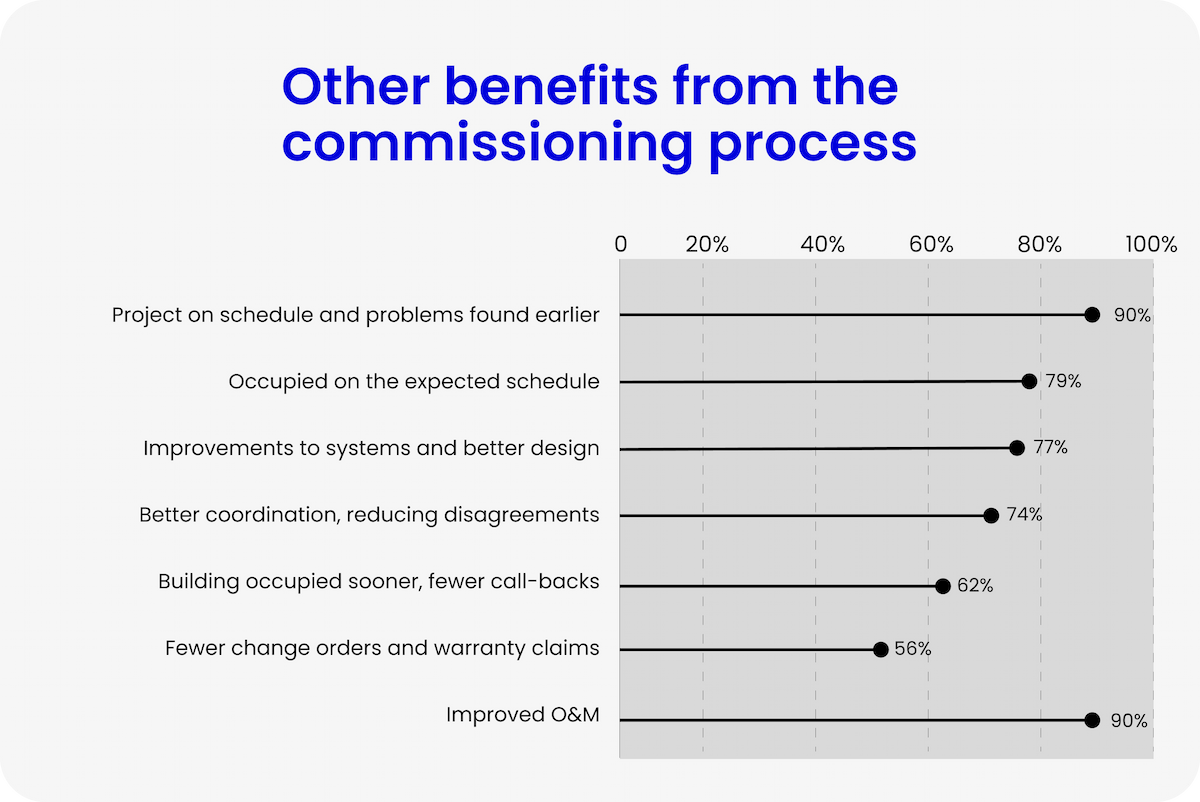 Introduction
Introduction
Commissioning is an essential step during building construction and the installation of complex building systems. However, it doesn't always happen. This can be due to the age of the building or a misunderstanding of the Cx process. Also, in cases where a building has been expanded or altered, a building's previous commissioning may no longer be valid.
Retro commissioning can solve these issues. RCx allows building owners and operations teams to take an existing building through the Cx process and improve its overall performance. This guide will explain retro commissioning and its importance.

 What is Retro-Commissioning?
What is Retro-Commissioning?
Retro commissioning is an after-the-fact commissioning process that helps identify a building's weaknesses and improves its overall performance.
This process involves performing an in-depth inspection and analysis of a building's systems and equipment to identify its components, determine their efficiency, and provide recommendations on how to improve the building's overall performance.
Retro Commissioning and Commissioning: The Differences
There are many differences between retro commissioning (RCx) and standard commissioning (Cx). While they both have similar goals, their processes and implementation can vary.
Commissioning and retro commissioning occur at different times:
- Commissioning occurs during building construction or the installation of a new system. This process ensures that the systems are installed to the plan's specifications and work properly and that the building is ready for occupation.
- Retro-commissioning occurs after a building has been constructed or the equipment has been installed - often years and years.
Due to their nature, Cx and RCx focus on different building components. Cx focuses on the new components installed to ensure they're calibrated and operating according to the design plan. RCx's focus is on improving the performance of the existing building components by identifying operational issues as well as system inefficiencies and deficiencies.
Also, the basis for the two tests is different. For instance, Cx uses the owner's project requirements (OPR) as the goals for the test, and the CxA identifies these early in the process to ensure the building meets those requirements. RCx utilizes current facility requirements (CFR), which are essentially the parameters that the building and its systems should meet to perform at their best.
 Reasons for Retro-Commissioning
Reasons for Retro-Commissioning
There are several reasons why a building owner or operations team would choose to have RCx performed on a building. The following are some of the most common reasons a building could benefit from RCx:
- Commissioning was never performed when the building was constructed or the system was installed.
- The building has been altered from its original plan, whether building owners upgraded systems, expanded its footprint, the original floor plan has changed, or the original use of the building has changed.
- There are components in the building that have never worked properly.
- Complaints about building comfort or functionality recently increased.
In any of these cases, RCx is typically the best route for assessing the building's current performance and getting it on track to perform efficiently again.
 The Retro-Commissioning Process
The Retro-Commissioning Process
The first step is identifying the requirements for commissioning. Instead of establishing the owner's project requirements, the RCx team needs to establish the current facility requirements and any potentially new requirements that might arise. The team identifies these parameters during an initial assessment of the building and its components. It then uses the CFR to verify and measure against through the RCx process. This assessment requires reviewing plans and performing walkthroughs and inspections, as well as testing individual systems to assess their functionality.
After the assessment, the RCx team will review its findings and analyze system weaknesses or deficiencies as well as make recommendations to improve the building's performance. Often, these suggestions are a fine-tuning of sorts, with small mechanical adjustments, settings tweaks, or small repairs, and they're assigned a priority based on their impact on the building's overall performance.
Once the building owner and operations team have a chance to implement the changes recommended as a result of the assessment, the system is tested and verified. This test is similar to a standard commissioning test, where a team works together to verify that all of the components and systems are working together as designed.
During the final stages of the retro commissioning process, the owner will receive updated operations and maintenance manuals. The RCx team might perform training as well. Final reports with findings, implemented actions taken, performance outcomes, and more will be provided to the project owner.
When to Implement RCx
Ideally, Cx will be performed during construction. and the ongoing maintenance outlined in the Cx process will sustain the building for years to come. However, it's often the case that facility owners who don't have Cx performed while their buildings are under construction turn to RCx during the operations phase.
RCx has many benefits for these facility owners, as it can help identify deficiencies or inefficiencies and help the building perform at its best. However, it's always better to have Cx performed during the construction phase to catch any issues early and ensure the systems are working efficiently from the start.
 Common Challenges in the Retro Commissioning Process
Common Challenges in the Retro Commissioning Process
While commissioning has its challenges, some challenges are unique to retro commissioning. These challenges are often due to the age of the building, in one way or another.
Lack of Plans and Documentation
An RCx team needs plans, manuals, and other documentation to perform its duties, but these items are often missing in older buildings. This makes tracking the systems' layouts, identifying components, or understanding system alterations much more difficult than a commissioning project where all the documents are readily available.
Lack of Access
It's often the case that systems, equipment, and components are hidden over a building's lifetime. While everything is out in the open during a Cx, these items might be hidden behind drywall, above ceilings, or in other areas that might be blocked off. Finding these items can be difficult during RCx and require more time.
Aging Equipment
Retro commissioning involves older buildings, often with aging equipment. These items can be prone to breaking during RCx, especially if they're being exercised for the first time in many years. Also, finding replacement parts or having to replace a condemned or discontinued unit is another set of challenges frequently faced during RCx.
Operational Inconveniences
By nature, retro commissioning typically occurs in established buildings. As a result, the RCx team will need to enter occupied spaces, inconveniencing typical operations. For example, RCx in a hospital might require shutting down an operating room. Or, RCx in a retail space might require setting up a ladder or lift in an area and cordoning it off from customers.
 The Benefits of Retro Commissioning
The Benefits of Retro Commissioning
Generally speaking, commissioned buildings output non-commissioned buildings. While RCx might not be the most ideal way to ensure a building is performing its best (Cx is!), there are several benefits that a building owner can take advantage of from RCx.
Quick Payback
According to two meta-analyses performed by E Mills in 2004 and 2009, the amount of time required for a retro commissioning project to pay for itself is just 1.1 years. This is significantly less time than a standard Cx, which takes 4.2 years. This is not to take away from the Cx process's value but to point out that non-commissioned buildings can significantly benefit from the process.
Energy Savings
One of the biggest benefits of retro commissioning is the amount of energy saved by assessing, testing, repairing, replacing, and adjusting poorly-running building equipment. According to E Mills' study, 25% of commissioned buildings can save up to 30% in energy consumption. Even the lowest 25% can save almost 10% in energy consumption.

Improved Equipment Lifespan
Putting existing equipment under the microscope and identifying the repairs and maintenance associated will typically result in a longer equipment lifespan. This reduces the frequency of repair or replacement, further improving savings and preventing unnecessary downtime.

Documentation Availability
RCx provides the building owner with a fresh set of documents required for their building. This can include new operations and maintenance manuals, property warranty or service documentation, and ongoing plans and training documents for long-term building use. This is a significant benefit, especially for buildings with a lack of proper documentation.
Healthier Indoor Air Quality
Improvements in indoor air quality are also a large benefit, especially in older buildings. By addressing IAQ concerns found during the assessment, optimizing the ventilation systems, implementing building air filtration, and controlling humidity levels, RCx teams can significantly improve the quality of air that the building occupants are breathing in.
 Choosing the Right Software for Retro Commissioning
Choosing the Right Software for Retro Commissioning
Choosing the right retro commissioning software is critical to obtaining the best results. CxPlanner allows users to plan and coordinate the entire commissioning process as well as communicate with the different parties involved. Read our guide to selecting the right commissioning software for your project.
Documenting process as well as collecting all of the drawings, photographs, and other data into one platform allows Cx teams and building managers to efficiently distribute and access information whenever it's needed. And, once it comes time for handover, CxPlanner simplifies the process for the best possible results and customer satisfaction.